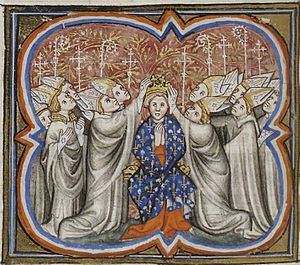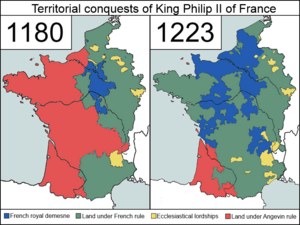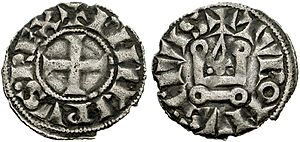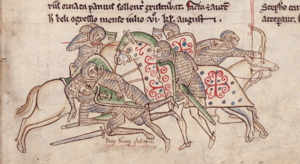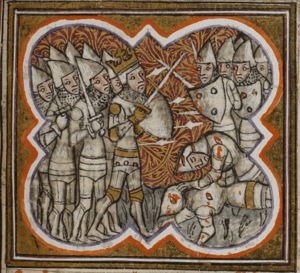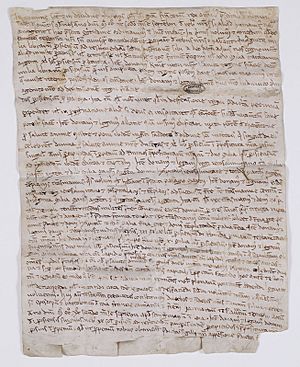Philip II of France facts for kids
Quick facts for kids Philip II |
|
|---|---|
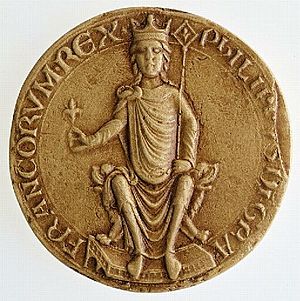
Seal of Philip II marked PHILIPPVS DEI GRATIA FRANCORUM REX (Philip, by the Grace of God, King of the Franks), 1180
|
|
| King of the Franks/France (more...) | |
| Senior king | 18 September 1180 – 14 July 1223 |
| Junior king | 1 November 1179 – 18 September 1180 |
| Coronation | 1 November 1179 |
| Predecessor | Louis VII |
| Successor | Louis VIII |
| Born | 21 August 1165 Gonesse, France |
| Died | 14 July 1223 (aged 57) Mantes-la-Jolie, France |
| Burial | Basilica of St Denis |
| Spouse | Isabella of Hainault (m. 1180, d. 1190) Ingeborg of Denmark (m. 1193 & 1200, wid. 1223) Agnes of Merania (m. 1196, an. 1200) |
| Issue full list... |
|
| House | Capet |
| Father | Louis VII of France |
| Mother | Adela of Champagne |
Philip II (born August 21, 1165 – died July 14, 1223), also known as Philip Augustus, was the King of France from 1180 to 1223. Before him, French kings were called "kings of the Franks." But from 1190, Philip was the first to call himself "King of France." He was the son of King Louis VII and his third wife, Adela of Champagne. People called him Dieudonné (God-given) because he was his father's first son, born late in his life. The name "Augustus" was given to him because he greatly expanded the lands controlled by the French crown.
Philip spent many years fighting the powerful House of Plantagenet, who were English kings but also held large parts of France. He finally ended their control by winning the Battle of Bouvines in 1214. This victory changed European politics forever. The French king's power became very strong. Meanwhile, the English King John was forced to sign the Magna Carta and faced a rebellion. Philip also helped expand France to the south through the Albigensian Crusade, even though he didn't fight in it himself.
Philip made France the richest and most powerful country in Europe. He reduced the power of the nobles and helped towns gain more freedom. He built a large wall around Paris, improved the government, and made the country's finances stable.
Contents
Early Life and Becoming King
Philip was born in Gonesse, France, on August 21, 1165. His parents were King Louis VII and Queen Adela of Champagne. He was called "Dieudonné" because he was the first son born to his father late in life.
King Louis VII wanted Philip to rule with him as soon as possible. But Philip became sick after a hunting trip. His father went on a pilgrimage to pray for his recovery. When he heard Philip was better, King Louis suffered a stroke on his way back to Paris.
Because his father was ill, 14-year-old Philip was crowned king on November 1, 1179, in Reims. He married Isabella of Hainault on April 28, 1180. Isabella brought the County of Artois as her wedding gift. After his coronation, Philip took over all royal power as his father's health declined. King Louis VII died on September 18, 1180.
Expanding Royal Lands
The lands directly controlled by the king, called the royal demesne, grew a lot under Philip II. In 1185, he gained the County of Amiens. He also bought the County of Clermont-en-Beauvaisis in 1218. After a count died in 1219, Philip also got the city and county of Alençon. His oldest son, Louis, inherited the County of Artois when Queen Isabella died in 1190.
Building a Strong Army
Philip's army was mainly paid for by the royal lands. When there was a conflict, he could quickly call up 250 knights and many other soldiers. By the end of his rule, the king could gather about 3,000 knights, 9,000 sergeants, and thousands of other fighters. Philip also used his money to build the first French navy. By 1215, his fleet could carry 7,000 men.
Changes for Jewish People
In 1180, Philip ordered Jewish people in France to give up their valuables. In April 1182, he expelled all Jewish people from the royal lands and took their belongings. He even had Jewish homes in Paris torn down to make way for a new market. These actions brought money to the crown. However, in 1198, Philip allowed Jewish people to return.
Wars with French Nobles
In 1181, Philip had a conflict with Count Philip I of Flanders over the Vermandois region. The Count of Flanders invaded France, but Philip's army chased him back. Philip had weakened the count's alliances. This led to a peace treaty in July 1185, which gave Philip more land, including Amiénois and Artois. It was during this time that the monk Rigord nicknamed Philip "Augustus" for increasing French lands.
Conflict with England
A major challenge for Philip was King Henry II of England. Henry was also a powerful ruler in France, controlling Normandy, Aquitaine, and Anjou. Philip made it his goal to weaken the English kings' power in France. He often befriended Henry's sons to cause trouble for their father.
Fighting Henry II
When Henry II's son, Henry the Young King, died in 1183, a dispute began over the dowry of Philip's sister, Margaret. Philip said the dowry should be returned because the marriage had no children. Philip and Henry met several times but could not agree.
Later, Henry's son Geoffrey died, leading to more arguments over who should control Brittany. Philip also brought up the issue of his other sister, Alys, and her delayed marriage to Henry's son Richard I of England, known as Richard the Lionheart.
Two years of fighting followed (1186–1188). Philip allied with Henry's sons, Richard and John, who were rebelling against their father. In 1189, Richard openly joined Philip. They forced Henry to accept Richard as his heir. Henry died two days later. The news of Jerusalem falling to Saladin then shifted attention away from the war.
The Third Crusade
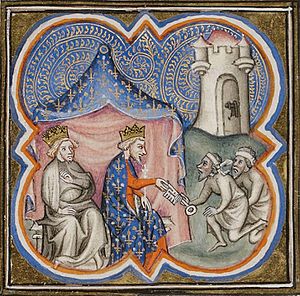
(illumination on parchment, c. 1375–1380, from the Grandes Chroniques de France in the Bibliothèque nationale de France)
Philip joined the Third Crusade (1189–1192) with King Richard I of England. They left France on July 4, 1190. The French and English armies traveled together for a while, then split up. Philip went by land to Genoa, and Richard went by sea. They met again in Messina for the winter.
On March 30, 1191, Philip sailed to the Holy Land. He arrived at Acre on April 20, where a siege was already happening. Philip started building siege equipment before Richard arrived on June 8. Acre surrendered on July 12. Philip became very sick with dysentery, which made him less eager to fight. Relations with Richard also became tense.
More importantly, the Count of Flanders died during the siege. This meant Philip needed to return to France to settle who would inherit the Vermandois region. Richard was not happy about this. Philip left the French army in the Holy Land under the command of Duke Hugh III of Burgundy. Philip returned to France, knowing that English lands in northern France would be open to attack while Richard was away.
Wars with England and Allies
Fighting Richard the Lionheart (1191–1199)
The conflict between Philip and Richard the Lionheart started when Richard broke his engagement to Philip's sister, Alys. Philip wanted the lands that were part of Alys's dowry back. He had sworn not to attack Richard's lands while Richard was on Crusade.
In 1192, Philip tried to claim disputed lands, but Richard's officials refused. Philip also spread rumors that Richard was working with Saladin. He even got Richard's brother, John, to join a plan to overthrow Richard.
In early 1193, John visited Philip in Paris and promised loyalty for Richard's lands in France. When Philip heard Richard had been captured on his way home from the Crusade, he invaded Vexin. He took the fortress of Gisors and went deep into Normandy. Philip and John even tried to bribe the Holy Roman Emperor to keep Richard imprisoned longer, but it didn't work. Richard was released on February 4, 1194.
Richard returned to Normandy in May 1194, ready to fight. Philip had taken control of much of Normandy east of the Seine River. Richard soon retook many fortresses. Philip's army was defeated at the Battle of Fréteval on July 3, where Philip barely escaped capture. Both sides were tired, and they agreed to a temporary truce.
The war continued in 1195. Richard gained a key ally in 1197, Baldwin of Flanders. Also, Richard's nephew, Otto IV, became Holy Roman Emperor, putting more pressure on Philip. Many Norman lords also switched back to Richard's side.
In September 1198, Richard attacked Philip's forces near the Epte River. Philip's knights tried to cross a bridge, but it collapsed, and Philip almost drowned. He was pulled out and took refuge in Gisors.
Philip soon planned new attacks. By autumn 1198, Richard had regained almost all the lands he had lost in 1193. Philip offered a truce, agreeing to return all territories except Gisors. In January 1199, the two kings met but could not agree on a lasting peace. They did agree to a five-year truce. Later in 1199, Richard was killed during a siege.
Fighting King John (1200–1206)
In May 1200, Philip signed the Treaty of Le Goulet with Richard's successor, King John. This treaty aimed to bring peace to Normandy. John agreed to harsh terms, giving up English lands in Berry and paying a large sum of money. In return, Philip recognized John as King of England. To seal the treaty, John's niece, Blanche of Castile, married Philip's son, Louis the Lion.
However, this agreement did not stop the fighting. John's poor rule in Aquitaine led to a rebellion, which Philip secretly encouraged. In 1202, unhappy nobles asked Philip to summon John to answer charges as his feudal lord. John refused to appear. So, Philip supported Arthur of Brittany's claim to the English throne. In retaliation, John captured Arthur. In 1203, Arthur disappeared, and many believed John had him murdered. This made people turn against John, and Philip used this to his advantage.
Philip went on the attack, taking most of Normandy and other English lands by the end of 1204. Philip then summoned John to appear before the French court for Arthur's murder. John refused, so Philip officially took away all of John's lands in France. In 1206, John tried to invade northern France but failed. He eventually agreed to a two-year truce, losing his French lands.
Alliances Against Philip (1208–1213)
In 1208, the Holy Roman Emperor, Philip of Swabia, was killed. His rival, Otto IV, King John's nephew, became emperor. Otto had promised to help John get back his lost lands in France. By 1212, both John and Otto were in conflict with Pope Innocent III. Philip decided to use this situation to his advantage. He helped a German rebellion against Otto. John then supported Otto, giving Philip a reason to plan an invasion of England.
Philip gathered his vassals for the invasion. He said John was an enemy of the Church, making his attack seem like a religious duty. The only noble who refused was Count Ferdinand of Flanders, who was angry about losing some towns to Philip's son.
Philip wanted to show his loyalty to the Pope to get support for his invasion. He made up with his estranged wife, Ingeborg, as the Pope had wanted. The Pope's representative, Pandulf Verraccio, encouraged Philip's plans. However, Verraccio was also secretly talking to King John. He convinced John to make peace with the Pope. John agreed to rule England and Ireland as the Pope's vassal.
Once John and the Pope made their agreement in May 1213, Verraccio told Philip he could not invade England. Attacking a loyal vassal of the Pope would be a serious sin. Philip argued that his plans had been approved by Rome, and he had spent a lot of money. Verraccio suggested an alternative: the Count of Flanders had refused to join the war, so Philip should punish him. Philip quickly agreed and marched his troops into Flanders.
The Battle of Bouvines (1214)
The French fleet went to Damme, but the English fleet captured many French ships. Philip ordered the remaining ships to be burned so they wouldn't fall into enemy hands.
This destruction made King John hopeful again. He prepared to invade France and retake his lost lands. John planned to attack from the Loire River, while Otto IV and the Count of Flanders attacked from the north. But the three armies did not work together well.
On July 27, 1214, the armies met near the bridge at Bouvines. It was a Sunday, and Philip did not expect an attack. Philip's army had about 7,000 soldiers, while the allied forces had around 9,000. The battle began. Philip was knocked off his horse, but his armor saved him. When Otto IV's horse was wounded and ran off, and the Count of Flanders was captured, the allied troops fled. The French won a decisive victory.
Philip returned to Paris in triumph, bringing his prisoners with him. After the battle, Otto IV was overthrown as Holy Roman Emperor. Count Ferdinand remained a prisoner. King John's attempt to rebuild his empire in France completely failed.
Philip's victory at Bouvines was very important for Western Europe. In England, the defeated King John was forced to sign the Magna Carta, which limited the king's power. The Battle of Bouvines marked the end of the English kings' large landholdings in France.
Marital Challenges
After his first wife, Isabella of Hainaut, died in 1190, Philip decided to marry again. On August 15, 1193, he married Ingeborg, daughter of King Valdemar I of Denmark. Philip met her and married her the same day. During the coronation ceremony, Philip seemed nervous and wanted it to end quickly. Afterward, he sent Ingeborg to a convent and asked the Pope for an annulment.
Ingeborg, however, insisted she was his rightful wife and queen. The Pope also supported Ingeborg. Meanwhile, Philip tried to marry again. He almost married Margaret of Geneva, but she was kidnapped. Finally, in June 1196, he married Agnes of Merania. They had two children, Marie and Philip.
Pope Innocent III declared Philip's marriage to Agnes invalid because he was still married to Ingeborg. When Philip didn't separate from Agnes, the Pope placed France under an interdict in 1199, which meant no church services could take place. This lasted until September 7, 1200. Due to pressure from the Pope and Agnes's death in 1201, Philip finally took Ingeborg back as his wife. But it wasn't until 1213 that she was fully recognized as queen at court.
Personality and Appearance
Philip was described as a "handsome, strapping fellow, bald but with a cheerful face of ruddy complexion." He enjoyed good living, wine, and women. He was generous to friends but strict with those who displeased him. He was clever and determined. He made quick and accurate decisions. He was known to be tough with powerful men who opposed him and liked to create disagreements among them. He never let an enemy die in prison. He preferred to work with humble people, to defeat the proud, protect the Church, and help the poor.
Children
- By Isabella of Hainault:
- Louis VIII (1187–1226), who became King of France. He married Blanche of Castile and had children.
- Robert (born and died 1190).
- Philip (born and died 1190).
- By Agnes of Merania:
- Marie (1198–1238); she married twice and had children.
- Philip (1200–1234), who became Count of Boulogne. He married Matilda II, Countess of Boulogne and had children.
- A son (born and died 1201).
- By a woman in Arras:
- Pierre Charlot, who became a bishop.
Later Years and Legacy
When Pope Innocent III called for a crusade against the Cathars in 1208, Philip did not directly support it, but he allowed his nobles to join. This war helped bring the south of France under the control of the French crown, a benefit reaped by Philip's son Louis VIII and grandson Louis IX.
Philip II Augustus played a big role in France's growth in construction and education. He made Paris his capital, paved its main roads, and built a central market called Les Halles. He continued building Notre-Dame de Paris and constructed the first version of the Louvre Palace as a fortress. In 1200, he gave a charter to the University of Paris, making Paris a leading city for learning in the medieval world.
Philip II became ill in September 1222. He died on July 14, 1223, at the age of 58, while traveling to Paris. His body was taken to Paris and buried in the Basilica of St Denis. His son and successor, Louis VIII, and other important figures were present.
Images for kids
See also
 In Spanish: Felipe II de Francia para niños
In Spanish: Felipe II de Francia para niños



